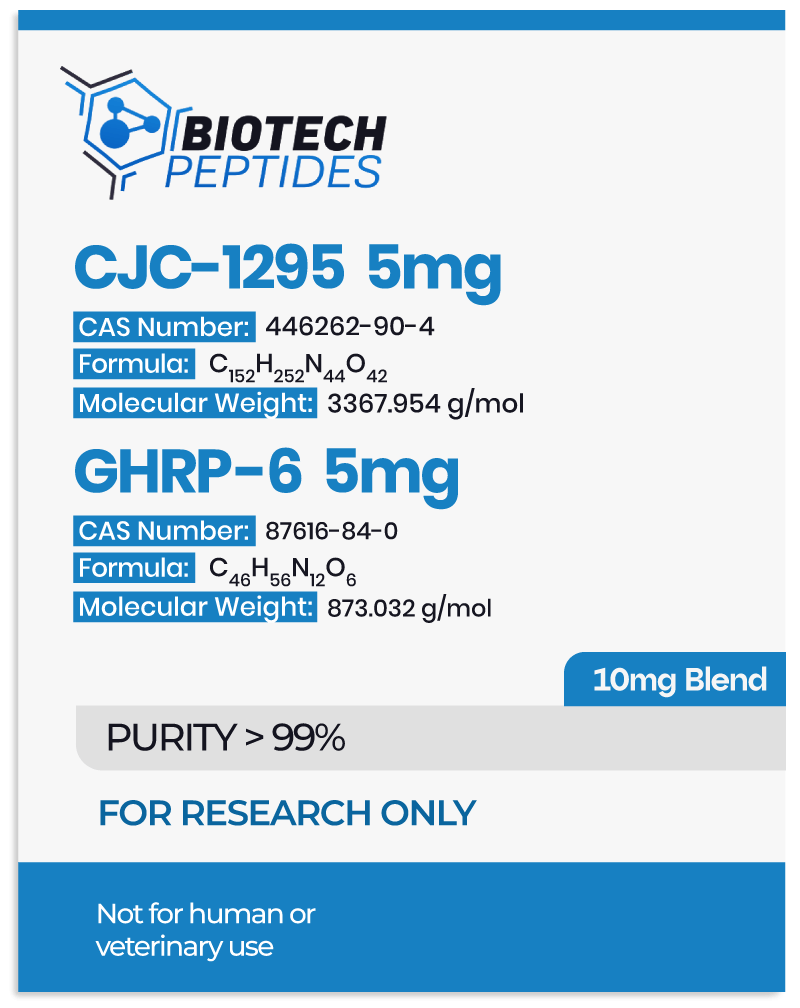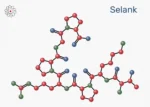The CJC-1295 and GHRP-6 blend may exhibit a potentially synergistic action on cells involved in growth hormone release. Combining these peptides may enhance both the amplitude and the frequency of the growth hormone pulses by somatotroph cells. This synergistic action is believed to be mediated through complementary mechanisms of action, as CJC-1295 appears to target the GHRH receptor pathway, while GHRP-6 may act on the ghrelin receptor pathway.
CJC-1295 & GHRP-6 Blend Structure and Affinity
CJC-1295, also known as tetra-substituted GRF (1-29), appears to be a synthetic peptide analog of the endogenous GHRH hormone. It comprises the shortest amino-acid chain that may possess an affinity to the GHRH receptors, and consists of the first 29 amino acids of GHRH. CJC-1295 appears to be modified as it has 4 of the original 29 amino acids replaced to potentially make the peptide more resistant to rapid cleavage by the enzyme dipeptidyl peptidase-4 and other peptides that appear to result in peptide inactivation[1]. More specifically, the amino acids that appear to be modified and replaced are the 2nd, 8th, 15th, and 27th amino acids. In addition, CJC-1295 has undergone modification by including a drug affinity complex (DAC) component, which may potentially bind to plasma proteins. The DAC component specifically refers to the attachment of a derivative of lysine called N-epsilon-3-maleimidopropionamide at the C terminus of CJC-1295. This combination of modified amino acid sequence and a DAC component may potentially enhance the pharmacokinetics of CJC-1295, while still maintaining an apparent affinity to the GHRH receptors. Indeed, scientists have commended that the peptide “was found to be present in plasma beyond 72 h.”[2]
On the other hand, GHRP-6 is a hexapeptide that appears to belong to the class of synthetic growth hormone-releasing peptides, which may act by potentially binding to the ghrelin receptor on the surface of pituitary cells and certain hypothalamic neurons. Upon binding, GHRP-6 appears to stimulate the so-called growth hormone secretagogue receptor (GHS-R1a). These receptors are also sometimes termed the ghrelin receptors, as ghrelin appears to be their main natural ligand. GHRP-6 appears to bind to these receptors, and may induce an intracellular calcium response and protein kinase C activity.[3] By activating them, GHRP-6 appears to stimulate the production of growth hormones in pituitary cells. In addition, GHRP-6 may also have an affinity for the CD36 receptors.[4] These CD36 receptors may serve multiple roles, including a potential action in lipid metabolism, acting as a scavenger receptor for lipids, facilitating their uptake, and potentially modulating immune responses, regulating phagocytosis and inflammation. CD36 pathways may also play a potential role in angiogenesis regulation.
CJC-1295 & GHRP-6 Blend and Somatotroph Cells
CJC-1295 appears to target somatotroph cells by potentially interacting with the GHRH receptor they express. More specifically, CJC-1295 may bind to specific binding sites on the receptor protein, leading to conformational changes in the receptor structure and potentially initiating a cascade of molecular events. These events appear initiated by intracellular signaling proteins acting as potential molecular switches.[5] These are the so-called G-proteins, which, once activated, may stimulate the potential production of second messengers like cyclic adenosine monophosphate (cAMP) or inositol trisphosphate (IP3).[6] Second messengers like cAMP may activate protein kinases, enzymes that are considered to modify specific proteins. These kinases have a regulatory potential towards cellular processes and may phosphorylate transcription factors, or proteins controlling gene expression. Phosphorylated transcription factors may enter the nucleus of somatotroph cells, potentially influencing genes related to growth hormone synthesis.[7] Ultimately, CJC-1295 binding appears to trigger events leading to the release of growth hormone from vesicles by the somatotroph cells. Researchers comment that the peptide may upregulate growth hormone production by somatotrophs, thus apparently contributing “to an overall increase in GH secretion … by 46%.” In turn, growth hormone appears to have a major anabolic mediator called insulin-like growth factor-1 (IGF-1). IGF-1 levels also apparently increased by 45%.[7] Another trial suggests that CJC-1295 may potentially upregulate “GH concentrations by 2- to 10-fold.”[8]
In contrast, GHRP-6 appears to interact with somatotroph cells via the GHS-R1a. More specifically, scientists posit that the peptide may apparently prefer an intracellular calcium response and protein kinase C activity instead of cAMP production.[9] The GHS-R1a activation appears to activate a specific unit of G-proteins inside somatotrophs. Gαq/11. This potentially preferred pathway by GHRP-6 apparently involves the enzyme phospholipase C. Gαq/11 may bind to phospholipase C, which may cleave a phospholipid called PIP2 into two messengers: the aforementioned IP3 and diacylglycerol (DAG).[10] IP3 appears to bind to receptors on the endoplasmic reticulum, releasing calcium ions, while DAG may activate protein kinase C, phosphorylating signaling molecules and amplifying the cascade. This potentially leads to the release of growth hormones by somatotroph cells.
Conclusion
In conclusion, the CJC-1295 & GHRP-6 blend may have a synergistic potential as they appear to interact with receptors in the central nervous system, particularly in the pituitary gland cells called somatotrophs. These peptides are hypothesized to have neuroendocrine actions and stimulate the release of growth hormones from the aforementioned somatotrophs. CJC-1295 appears to bind the GHRH receptors in the pituitary gland, potentially leading to conformational changes and the activation of intracellular signaling pathways for growth hormone production. On the other hand, GHRP-6 may bind to the GHS-R1a receptors, also known as ghrelin receptors, with a potential preference for an intracellular calcium response and protein kinase C activity instead of cAMP production. This may also initiate a cascade of molecular events, potentially resulting in the release of growth hormones.
Disclaimer: The products mentioned are not intended for human or animal consumption. Research chemicals are intended solely for laboratory experimentation and/or in-vitro testing. Bodily introduction of any sort is strictly prohibited by law. All purchases are limited to licensed researchers and/or qualified professionals. All information shared in this article is for educational purposes only.
References
- Scarborough, R., Gulyas, J., Schally, A. V., & Reeves, J. J. (1988). Analogs of growth hormone-releasing hormone induce release of growth hormone in the bovine. Journal of animal science, 66(6), 1386–1392. https://doi.org/10.2527/jas1988.6661386x
- Jetté, L., Léger, R., Thibaudeau, K., Benquet, C., Robitaille, M., Pellerin, I., Paradis, V., van Wyk, P., Pham, K., & Bridon, D. P. (2005). Human growth hormone-releasing factor (hGRF)1-29-albumin bioconjugates activate the GRF receptor on the anterior pituitary in rats: identification of CJC-1295 as a long-lasting GRF analog. Endocrinology, 146(7), 3052–3058. https://doi.org/10.1210/en.2004-1286
- Sun, Q., Ma, Y., Zhang, L., Zhao, Y. F., Zang, W. J., & Chen, C. (2010). Effects of GH secretagogues on contractility and Ca2+ homeostasis of isolated adult rat ventricular myocytes. Endocrinology, 151(9), 4446–4454. https://doi.org/10.1210/en.2009-1432
- Demers, A., McNicoll, N., Febbraio, M., Servant, M., Marleau, S., Silverstein, R., & Ong, H. (2004). Identification of the growth hormone-releasing peptide binding site in CD36: a photoaffinity cross-linking study. The Biochemical journal, 382(Pt 2), 417–424. https://doi.org/10.1042/BJ20040036
- Martin, B., Lopez de Maturana, R., Brenneman, R., Walent, T., Mattson, M. P., & Maudsley, S. (2005). Class II G protein-coupled receptors and their ligands in neuronal function and protection. Neuromolecular medicine, 7(1-2), 3–36. https://doi.org/10.1385/nmm:7:1-2:003
- Newton, A. C., Bootman, M. D., & Scott, J. D. (2016). Second Messengers. Cold Spring Harbor perspectives in biology, 8(8), a005926. https://doi.org/10.1101/cshperspect.a005926
- Ionescu, M., & Frohman, L. A. (2006). Pulsatile secretion of growth hormone (GH) persists during continuous stimulation by CJC-1295, a long-acting GH-releasing hormone analog. The Journal of clinical endocrinology and metabolism, 91(12), 4792–4797. https://doi.org/10.1210/jc.2006-1702
- Teichman, S. L., Neale, A., Lawrence, B., Gagnon, C., Castaigne, J. P., & Frohman, L. A. (2006). Prolonged stimulation of growth hormone (GH) and insulin-like growth factor I secretion by CJC-1295, a long-acting analog of GH-releasing hormone, in healthy adults. The Journal of clinical endocrinology and metabolism, 91(3), 799–805. https://doi.org/10.1210/jc.2005-1536
- Sinha, D. K., Balasubramanian, A., Tatem, A. J., Rivera-Mirabal, J., Yu, J., Kovac, J., Pastuszak, A. W., & Lipshultz, L. I. (2020). Beyond the androgen receptor: the role of growth hormone secretagogues in the modern management of body composition in hypogonadal males. Translational andrology and urology, 9(Suppl 2), S149–S159. https://doi.org/10.21037/tau.2019.11.30
- Bill, C. A., & Vines, C. M. (2020). Phospholipase C. Advances in experimental medicine and biology, 1131, 215–242. https://doi.org/10.1007/978-3-030-12457-1_9







